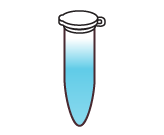Custom siRNA/shRNA Vector & Virus
abm offers a Custom siRNA/shRNA Vector and Virus Service enabling efficient knockdown of your gene of interest. Our constructs are available as a single or set of 4, in lentiviral or AAV format and with or without a GFP reporter. The service includes cloning of a verified siRNA using our database of over 20,000 targets. If your gene of interest is not yet published, we will design four target sequences using our advanced siRNA software. Inquire with us below to get started on your Custom siRNA project.
Additional Resources:
Custom Lentivector & Virus siRNA/shRNA Services
| Service | Product | Unit | Titer | Cat. No. | Price |
|---|---|---|---|---|---|
|
Custom iLenti™ siRNA Lentivector Cloning |
1 iLenti™-GFP Construct | 500 ng | - | C043‑G | $85.00 |
| 1 iLenti™ Construct | 500 ng | - | C043 | $85.00 | |
| 4 iLenti™-GFP Construct | 4 x 500 ng | - | C044‑G | $275.00 | |
| 4 iLenti™ Construct | 4 x 500 ng | - | C044 | $275.00 | |
| Negative Control Scramble Vector with GFP | 500ng | - | LV015‑G | $85.00 | |
| Negative Control Scramble Vector | 500ng | - | LV015 | $85.00 | |
|
Custom iLenti™ siRNA Lentivirus Production |
1 iLenti™-GFP Construct, Packaged Lentivirus | 4 x 500 μl | 107 IU/ml | C043V‑G | $375.00 |
| 1 iLenti™ Construct, Packaged Lentivirus | 4 x 500 μl | 107 IU/ml | C043V | $375.00 | |
| 4 iLenti™-GFP Constructs, Pooled Lentivirus | 4 x 500 μl | 107 IU/ml | C044V‑G | $565.00 | |
| 4 iLenti™ Constructs, Pooled Lentivirus | 4 x 500 μl | 107 IU/ml | C044V | $565.00 | |
| Scrambled siRNA GFP Lentivirus | 4 x 500 μl | 107 IU/ml | LVP015‑G | $285.00 | |
| Scrambled siRNA Lentivirus | 4 x 500μl | 107 IU/ml | LVP015 | $285.00 | |
| Custom shRNA | Upgrade to shRNA | 1 Service | - | C518 | $125.00 |
Custom AAV Vector & Virus siRNA/shRNA Services
| Service | Product | Unit | Titer | Cat. No. | Price |
|---|---|---|---|---|---|
| Custom AAV siRNA Vector | Custom AAV siRNA Vector (1 siRNA) | 1.0 μg | C519 | $135.00 | |
| Custom AAV siRNA Vector (Set of 4 siRNA) | 4 x 1.0 μg | iAAV04400 | $395.00 |
||
| Scrambled AAV siRNA Control Vector | 1.0 μg | iAAV01500 | $135.00 | ||
| Custom AAV siRNA Pooled Virus | Standard Titer AAV siRNA Pooled Virus | 3 x 100 μl | 1011 GC/ml | $670.00 | |
| Scrambled AAV siRNA Control Virus | 3 x 100 μl | 1011 GC/ml | $262.00 | ||
| Custom shRNA | Upgrade to shRNA | 1 Service | C518 | $125.00 |
Available siRNA & shRNA Vectors
 |
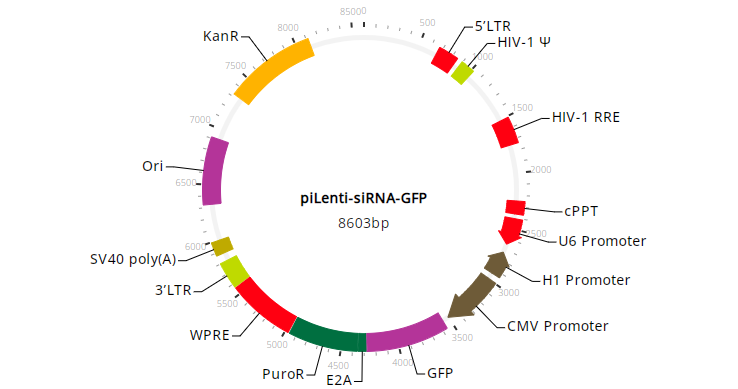 |
| iLenti™ Vector | iLenti™-GFP Vector |
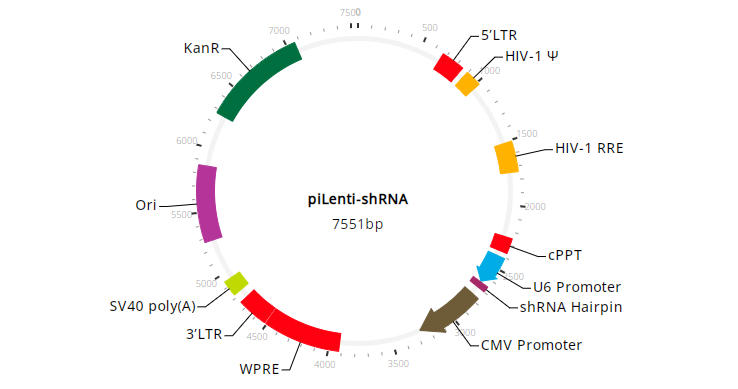 |
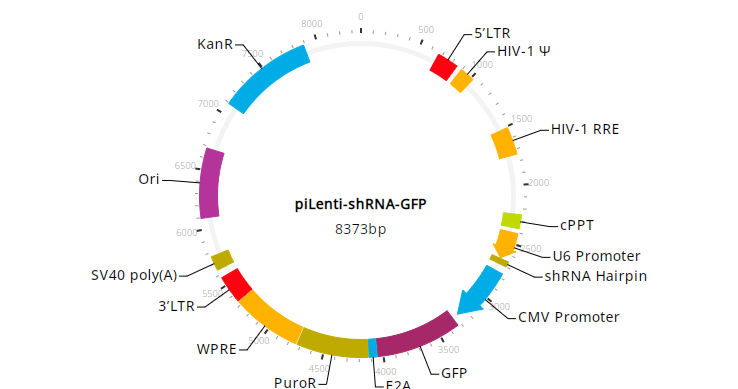 |
| iLenti™ shRNA Vector | iLenti™-shRNA GFP Vector |
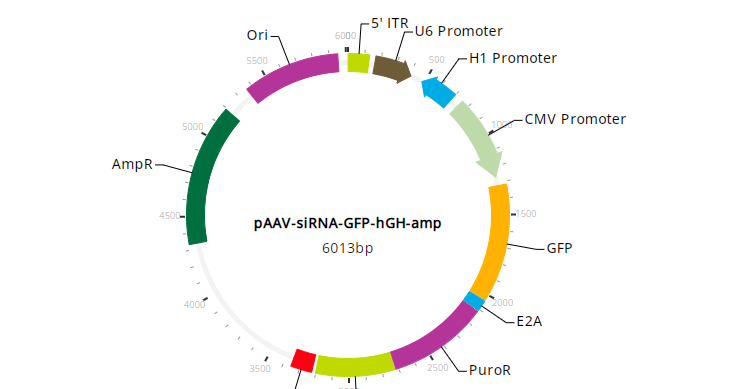 |
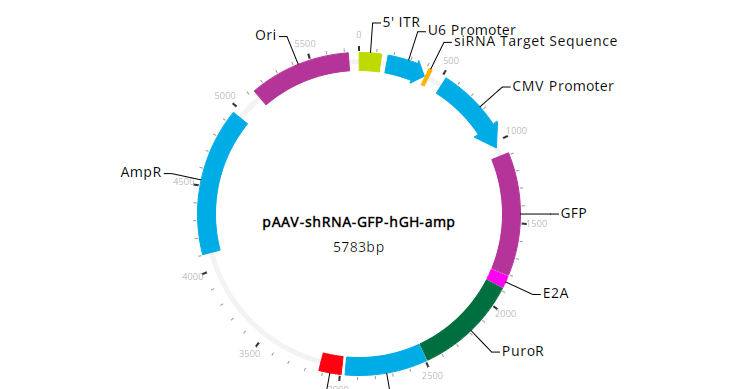 |
| AAV siRNA Vector | AAV shRNA Vector |
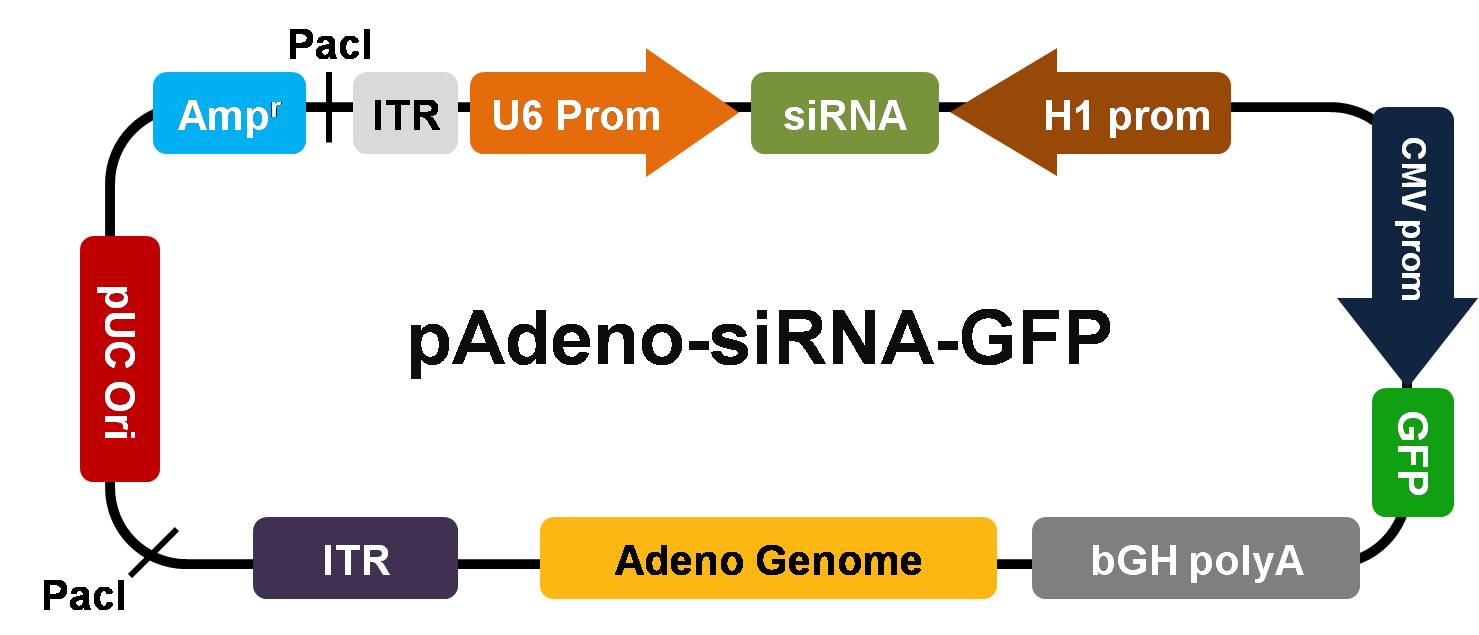 |
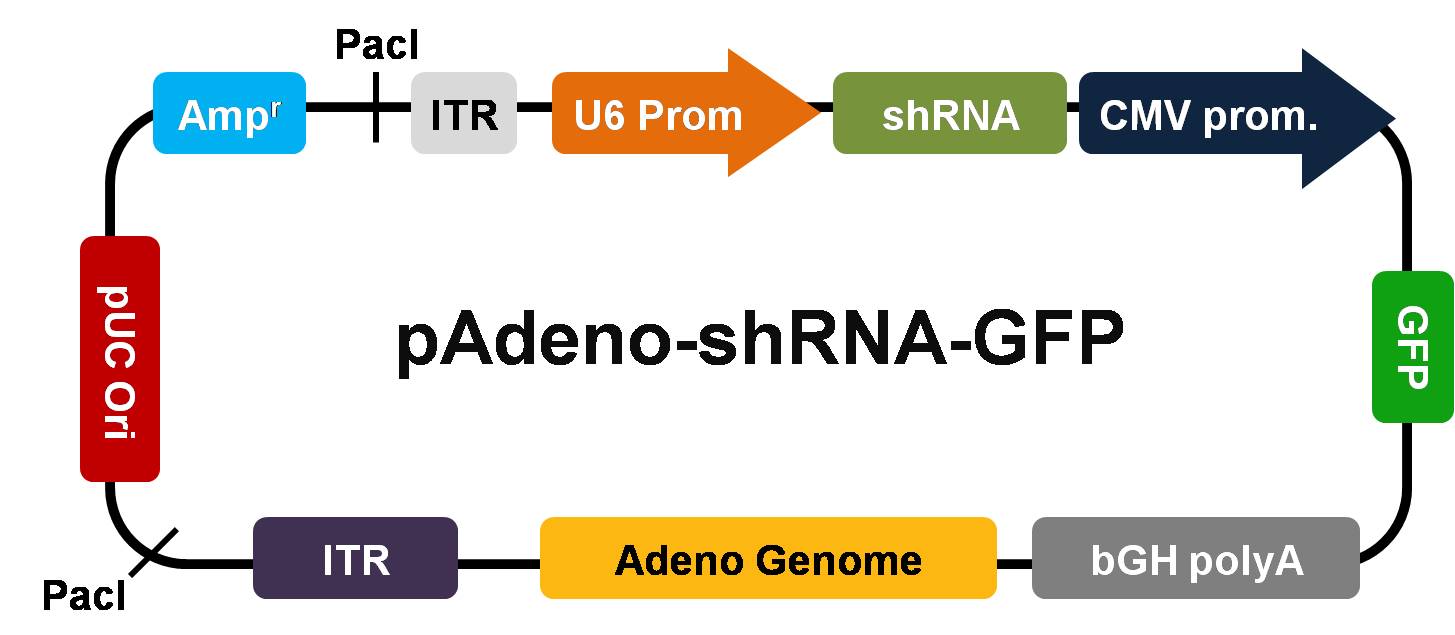 |
| Adeno siRNA Vector | Adeno shRNA Vector |
Disclaimer
Our RNA interference lentiviral vectors contain siRNAs. We employ a dual-convergent promoter system where the sense and antisense strands of the siRNA are expressed by two different promoters rather than in a hairpin loop - this is to avoid any possible recombination events that can occur.
abm guarantees that at least one out of the four siRNA Lentivector constructs purchased in a set will result in over 70% knockdown of gene expression within target cells showing >80% transfection efficiency. If this is not the case, we will provide a one-time replacement of four new constructs with alternative siRNA sequences. To qualify for this replacement, the vectors must be transfected at ≥5 nM and assayed 48 hours post-transfection. Customers must provide adequate data to show >80% transfection efficiency with a positive control, plus additional qPCR data to evaluate the level of gene expression. The replacement set will not covered by the same guarantee, and if these constructs are also considered to be ineffective then, it is most likely the gene is not susceptible to siRNA knockdown.
abm limits its obligation and liability for the success of this technology to providing one replacement of any siRNA lentivector product only. Before sending your inquiry, please make sure you have extensively optimized your experiments, including (where applicable) increasing your MOI, increasing the duration of infection (up to 72 hours), and carrying out clone screening before assaying for knockdown. Please send all replacement inquiries and experimental data to technical@abmgood.com.
*Due to the unpredictable nature of customized knockdown, this guarantee does not apply to siRNAs designed 1) against species other than human, mouse, or rat, 2) against regions other than the coding region (CDS), or 3) with customer-provided siRNA target sequences. All sales are final for custom designs.
NOT FOR RESALE without prior written consent of abm. This product is distributed for laboratory research only. Caution: Not for diagnostic use.
abm guarantees that at least one out of the four siRNA Lentivector constructs purchased in a set will result in over 70% knockdown of gene expression within target cells showing >80% transfection efficiency. If this is not the case, we will provide a one-time replacement of four new constructs with alternative siRNA sequences. To qualify for this replacement, the vectors must be transfected at ≥5 nM and assayed 48 hours post-transfection. Customers must provide adequate data to show >80% transfection efficiency with a positive control, plus additional qPCR data to evaluate the level of gene expression. The replacement set will not covered by the same guarantee, and if these constructs are also considered to be ineffective then, it is most likely the gene is not susceptible to siRNA knockdown.
abm limits its obligation and liability for the success of this technology to providing one replacement of any siRNA lentivector product only. Before sending your inquiry, please make sure you have extensively optimized your experiments, including (where applicable) increasing your MOI, increasing the duration of infection (up to 72 hours), and carrying out clone screening before assaying for knockdown. Please send all replacement inquiries and experimental data to technical@abmgood.com.
*Due to the unpredictable nature of customized knockdown, this guarantee does not apply to siRNAs designed 1) against species other than human, mouse, or rat, 2) against regions other than the coding region (CDS), or 3) with customer-provided siRNA target sequences. All sales are final for custom designs.
NOT FOR RESALE without prior written consent of abm. This product is distributed for laboratory research only. Caution: Not for diagnostic use.
Related Products
FAQs
|
It is specifically designed that it should bring down any gene based on sequence search. Using antibiotics as your selection marker can show whether the negative control was successfully incorporated by the cell.
|
| Does the final siRNA produced by this system have overhangs or not? |
|
Once expressed in the host cell, Dicer will process the expressed dsRNA duplex into siRNA with 3' overhangs.
|
| I want to linearize the siRNA vector for electroporation purposes. Can you suggest a cut site outside the expression cassette that I can use? |
|
HpaI or PacI will work to linearize the vector. Both sites are located outside of the LTRs.
|
| I am having difficulties linearizing my vector with PacI, can you suggest any reasons why this isn't working? |
|
In our experience, PacI is an inefficient cutter and when carrying out in-house digests with this enzyme, we will normally do a 3 hour digestion. We suggest doing a 20-fold overdigestion at 3 hours to linearize the vector if you choose to use use this site.
|
| Can I use the BbsI sites shown on the map to cut the siRNA insert out of the vector? |
|
The BbsI sites shown on the vector map of our siRNA constructs are used for cloning the siRNA inserts into the vector backbone. Once the cloning step is carried out these sites are destroyed and cannot be used to cut out the insert from the vector for further downstream applications.
|
| What primers can I use to sequence my vectors? |
|
One forward sequencing reaction using the U6 primer should be sufficient: U6 forward sequencing primer 5'-TACGTCCAAGGTCGGGCAGGAAGA-3' You can use the H1 Primer to sequence in the reverse direction if required: H1 sequencing primer: 5'-CAACCCGCTCCAAGGAATCG-3'
|
Citations
| 01 | Tamura, M et al. "Forkhead transcription factor FOXF1 is a novel target gene of the p53 family and regulates cancer cell migration and invasiveness." Oncogene : (2013). 6:8371PubMed: 24186199 Application: siRNA. |
| 02 | Xin, H;Li, Y;Liu, Z;Wang, X;Shang, X;Cui, Y;Zhang, ZG;Chopp, M;, et al. "MiR-133b promotes neural plasticity and functional recovery after treatment of stroke with multipotent mesenchymal stromal cells in rats via transfer of exosome-enriched extracellular particles." Stem Cells 12:2737-46 (2013). PubMed: 23630198 |
| 03 | Fujiya, M;Konishi, H;Mohamed Kamel, MK;Ueno, N;Inaba, Y;Moriichi, K;Tanabe, H;Ikuta, K;Ohtake, T;Kohgo, Y;, et al. "microRNA-18a induces apoptosis in colon cancer cells via the autophagolysosomal degradation of oncogenic heterogeneous nuclear ribonucleoprotein A1." Oncogene : (2013). PubMed: 24166503 |
| 04 | Saghizadeh, M et al. "Enhanced wound healing, kinase and stem cell marker expression in diabetic organ-cultured human corneas upon MMP-10 and cathepsin F gene silencing." Invest. Ophthalmol. Vis. Sci. 54:8172 - 80 (2013). DOI: 10.1167/iovs.13-13233 PubMed: 24255036 Application: siRNA. |
| 05 | Sasaki, Y et al. "CLCA2, a target of the p53 family, negatively regulates cancer cell migration and invasion.." Cancer Biology & Therapy 14:1512-1521 (2012). PubMed: 22990203 Application: siRNA. |
| 06 | Yokota, I et al. "Identification and characterization of early growth response 2, a zinc-finger transcription factor, as a p53-regulated proapoptotic gene.." International Journal of Oncology 6:1407-1416 (2010). PubMed: 21042708 Application: siRNA. |
| 07 | Jin, Q et al. "Decreased Tumor Progression and Invasion by a Novel Anti-Cell Motility Target for Human Colorectal Carcinoma Cells." pLOS One 6:e66439 (0). PubMed: 23755307 Application: siRNA. |

